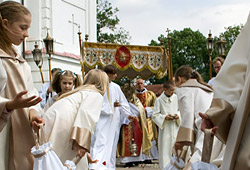Esmė
Every person is God’s handiwork and is called to walk with his or her Creator. The life of a Christian is a pilgrimage, a journey with and toward the Lord, to the home of our heavenly Father. According to Sacred Scripture, we are only visitors on this Earth, people passing through, but at the end of our journey we shall be fellow citizens with the saints and members of God’s household (cf. Eph 2, 19).
Old Testament Roots
Already the Old Testament reveals the path of humanity’s pilgrimage, a path that is paved with the freedom the Creator gives to each person. The journey, which began from Creation itself, very soon lost its way as disobedience disrupted the bonds of friendship with the Creator. However, God’s constant care kept the hope of deliverance alive, so that for those who trusted him, the journey of life became a path of conversion and of return to the Lord. The Old Testament is brimming with God’s invitations to walk with him as Abraham did when, trusting the divine pledge, he left his native soil and set off for the land the Lord had promised. God freed his chosen people Israel from slavery in Egypt and accompanied it through the desert, protecting it and helping it to mature along the way to the Promised Land. Pilgrimage, in the Old Testament, is thus a journey of trust in the Lord and of faithfulness to him.
Jesus Christ the True Pilgrim
Christians view their Lord Jesus Christ as the true pilgrim whose example they are called to follow. The life of Christ was a continual pilgrimage: his Incarnation, his presentation in the Temple, his trip with Joseph and Mary to Jerusalem… In fact, his entire life was directed toward Jerusalem. However, the Jesus’ road did not end with the Crucifixion, but continued on to his Resurrection and Ascension into Heaven. In the same way, the Christian’s journey does not only involve taking up one’s daily cross and following Jesus, but also leads to where there shall be no more death, sorrow or suffering (cf. Apoc 21, 4). Christ accompanies Christians along the pathways of this Earth, explaining the meaning of the Scriptures and breaking the bread of the Eucharist. That means Christians are not alone in their pilgrimage, for together with them walks Christ, “the Way, the Truth and the Life” (John 14, 6).
The Pilgrim Church
The Church also considers itself a pilgrim en route to its heavenly Spouse. Over the centuries, multitudes of the Church’s children have been inspired to set off along the paths of the world, led by a lively faith and a spirit of penance, and renouncing at least for a short time the normal comforts of life and their status in society. They have wanted to identify themselves in all ways with the Lord Jesus Christ, who while living on this Earth had nowhere to lay his head.
Mary, a Pilgrim of Faith
The Blessed Virgin Mary, Mother of God, is an ideal example for pilgrims. She was the first to believe in the Emmanuel, God with us, whom she carried within herself and thus became a living temple of God. From her pilgrims learn to journey in faith, hope and love, listening to the Word of God, celebrating the Sacraments and giving themselves to their brothers and sisters.
Pilgrimage and Encounter
The pilgrim’s path leads to an encounter with God. At each stage of the journey, in every shrine, the Lord fulfils his promise and the pilgrim meets the divine mystery, glimpsing the loving and merciful face of God. In the course of his or her pious expedition, the pilgrim becomes conscious of the existential vocation to converse with God. The Christian pilgrimage tradition sheds light on a fundamental difference between Christianity and other religions: the Creator is not some distant, anonymous force, but rather a Father, and we are all his children, brothers and sisters in Christ the Lord.
The pilgrim’s path also leads to an encounter with the Church. Living a pilgrimage together with others gives one a new vision of the People of God journeying toward the Eternal City, united in one faith and in the love of Christ. The pilgrim becomes more aware of what it means to be a member of God’s family, surrounded by many brothers and sisters in the faith and led by the Good Shepherd through the visible shepherds to whom he has entrusted his sheep.
Also awaiting the pilgrim is an encounter with a shrine. So often the holy place serves as a prod for one’s conscience, leading pilgrims to confess their sins, to receive forgiveness and to forgive others. Through the Sacrament of Penance, or Reconciliation, the pilgrim is created anew by the experience of God’s grace and mercy. During the journey itself, a pilgrim should feel like the prodigal son, travelling through suffering, hunger and difficulties along the path that leads to home, firmly believing in the infinite depth and power of God’s gift of forgiveness.
The Spirit of Christian Pilgrimage
The pilgrim, on his or her way to an encounter with the Lord, should foster a spirit of repentance, of desire for conversion, forgiveness and reconciliation. Thus the Sacrament of Reconciliation is an essential element of a pilgrimage. The pilgrim’s weapon is the Word of God, and his food is the Eucharist. Inside, the pilgrim burns with gratitude to the Lord and desire to worship him. Pilgrims usually set out to request graces not only for themselves but also for others, and for their homeland, and for the entire world. Acts of charity and mercy should accompany the prayers of a pilgrim. In this way the life of a true pilgrim is a constant proclamation of the Good News of the Gospel: God so loved the world that he did not spare his only Son so people of every time and generation might be freed from the slavery of sin.







